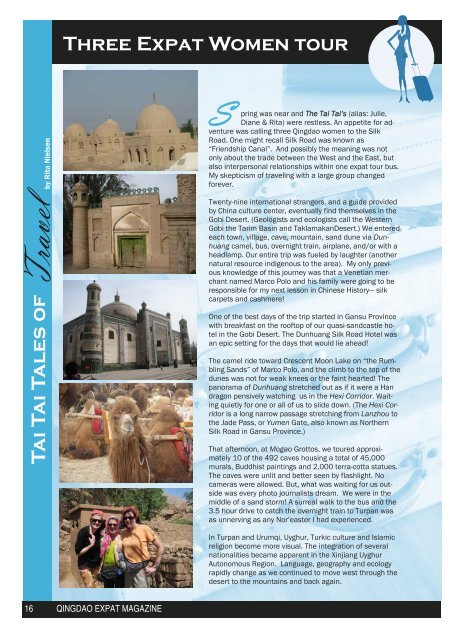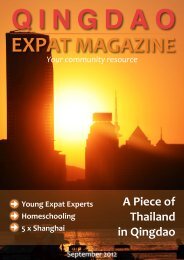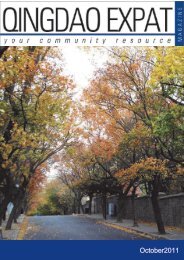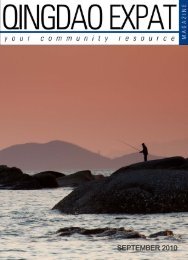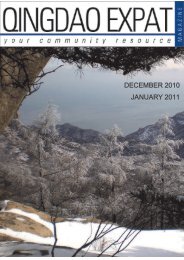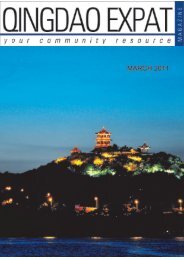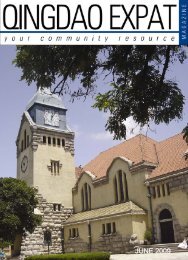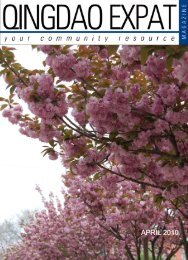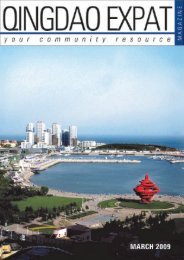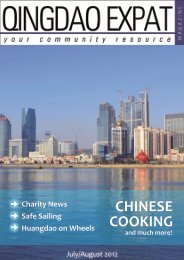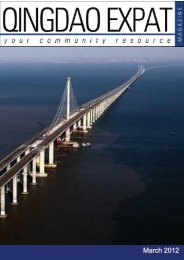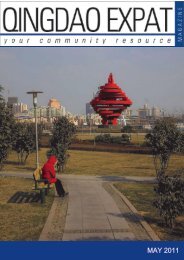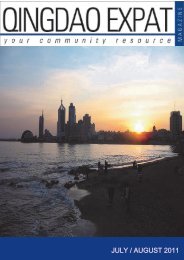July August 2009.pub - Qingdao Expat Group
July August 2009.pub - Qingdao Expat Group
July August 2009.pub - Qingdao Expat Group
You also want an ePaper? Increase the reach of your titles
YUMPU automatically turns print PDFs into web optimized ePapers that Google loves.
Three <strong>Expat</strong> Women tour<br />
Rita Nielsen<br />
Tai Tai Tales of Travel by<br />
S<br />
pring was near and The Tai Tai’s (alias: Julie,<br />
Diane & Rita) were restless. An appetite for adventure<br />
was calling three <strong>Qingdao</strong> women to the Silk<br />
Road. One might recall Silk Road was known as<br />
“Friendship Canal”. And possibly the meaning was not<br />
only about the trade between the West and the East, but<br />
also interpersonal relationships within one expat tour bus.<br />
My skepticism of traveling with a large group changed<br />
forever.<br />
Twenty-nine international strangers, and a guide provided<br />
by China culture center, eventually find themselves in the<br />
Gobi Desert. (Geologists and ecologists call the Western<br />
Gobi the Tarim Basin and TaklamakanDesert.) We entered<br />
each town, village, cave, mountain, sand dune via Dunhuang<br />
camel, bus, overnight train, airplane, and/or with a<br />
headlamp. Our entire trip was fueled by laughter (another<br />
natural resource indigenous to the area). My only previous<br />
knowledge of this journey was that a Venetian merchant<br />
named Marco Polo and his family were going to be<br />
responsible for my next lesson in Chinese History— silk<br />
carpets and cashmere!<br />
One of the best days of the trip started in Gansu Province<br />
with breakfast on the rooftop of our quasi-sandcastle hotel<br />
in the Gobi Desert. The Dunhuang Silk Road Hotel was<br />
an epic setting for the days that would lie ahead!<br />
The camel ride toward Crescent Moon Lake on “the Rumbling<br />
Sands” of Marco Polo, and the climb to the top of the<br />
dunes was not for weak knees or the faint hearted! The<br />
panorama of Dunhuang stretched out as if it were a Han<br />
dragon pensively watching us in the Hexi Corridor. Waiting<br />
quietly for one or all of us to slide down. (The Hexi Corridor<br />
is a long narrow passage stretching from Lanzhou to<br />
the Jade Pass, or Yumen Gate, also known as Northern<br />
Silk Road in Gansu Province.)<br />
That afternoon, at Mogao Grottos, we toured approximately<br />
10 of the 492 caves housing a total of 45,000<br />
murals, Buddhist paintings and 2,000 terra-cotta statues.<br />
The caves were unlit and better seen by flashlight. No<br />
cameras were allowed. But, what was waiting for us outside<br />
was every photo journalists dream. We were in the<br />
middle of a sand storm! A surreal walk to the bus and the<br />
3.5 hour drive to catch the overnight train to Turpan was<br />
as unnerving as any Nor’easter I had experienced.<br />
In Turpan and Urumqi, Uyghur, Turkic culture and Islamic<br />
religion become more visual. The integration of several<br />
nationalities became apparent in the Xinjiang Uyghur<br />
Autonomous Region. Language, geography and ecology<br />
rapidly change as we continued to move west through the<br />
desert to the mountains and back again.<br />
16 QINGDAO EXPAT MAGAZINE


